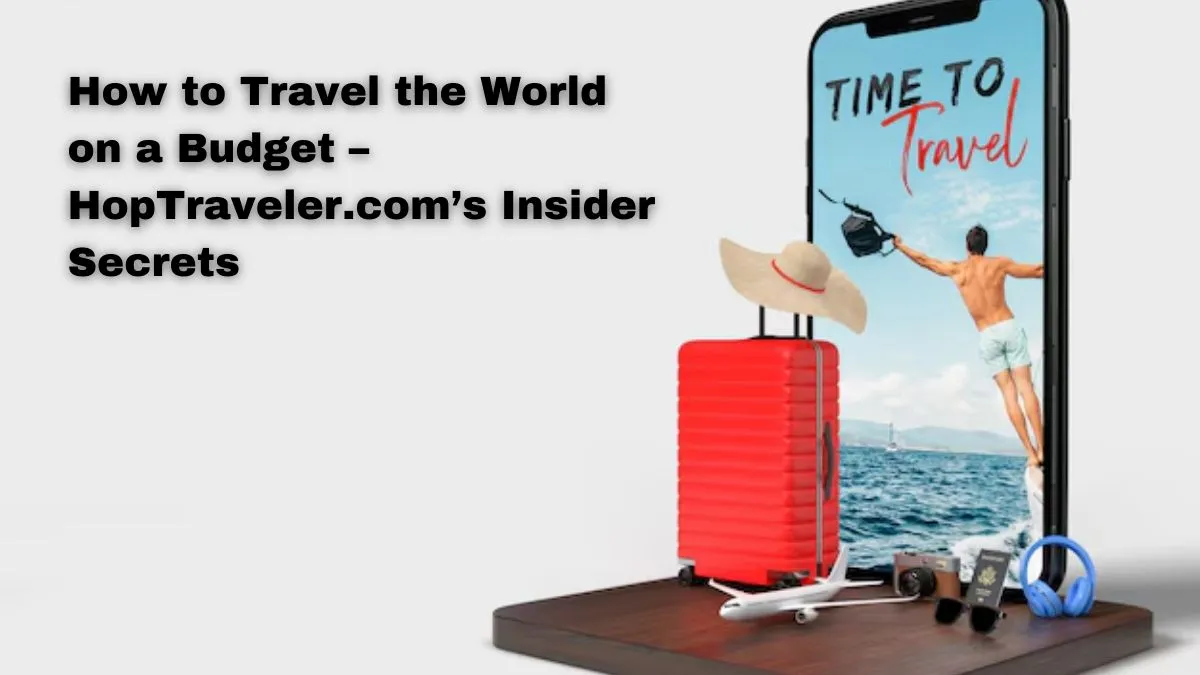Travel
How to Travel the World on a Budget –Insider Secrets of HopTraveler.com

Traveling the world doesn’t have to drain your bank account. Many think it’s a luxury. But HopTraveler.com proves otherwise. You just need the right strategy. A well-planned budget trip can be more enriching than an expensive one. Imagine waking up in a cozy guesthouse, eating local street food, and exploring hidden gems without spending much. It’s possible. Travel smart, not expensive. HopTraveler.com has helped countless travelers do this. Through research, hacks, and personal experiences, we reveal secrets that make budget travel easy. Whether you’re a backpacker, digital nomad, or just someone craving adventure, this guide will change the way you see travel. Ready to explore the world without breaking the bank? Let’s go.
Planning Your Budget-Friendly Trip
A good trip starts with a solid plan. No, you don’t need a detailed itinerary. Just a roadmap. HopTraveler.com suggests setting a daily budget first. How much can you spend per day? Decide that. Then pick destinations where your money stretches further. Southeast Asia? Perfect. Eastern Europe? Affordable. Research is key. Look for free attractions, budget accommodations, and cheap transport. Avoid touristy seasons—everything’s pricier then. Use travel forums and blogs like HopTraveler.com to find deals. Always book flights and stays in advance. But leave room for flexibility. The best experiences? Often unplanned. A little research, some smart choices, and you’ll travel more for less.
Finding Cheap Flights and Transportation
Flights eat up your budget fast. Unless you know the tricks. HopTraveler.com swears by flight comparison sites—Google Flights, Skyscanner, Momondo. Always search in incognito mode. Airlines track searches, hike prices. Be flexible with dates. Mid-week flights? Cheaper. Red-eye flights? Even better. Budget airlines? Yes, but watch for hidden fees. Checked bags? Costly. Travel light. Trains, buses, and shared rides save money too. Ever tried BlaBlaCar? Cheap and fun. City passes offer unlimited transport at low costs. Walking? The best. It’s free, and you see more. HopTraveler.com always says: The less you spend on getting there, the more you spend experiencing.
Affordable Accommodation Options
Why pay for fancy hotels when better, cheaper options exist? HopTraveler.com recommends hostels—not just for backpackers. Many offer private rooms. Airbnb? Great, if booked early. House-sitting? Free stays in exchange for pet care. Couchsurfing? Yes, it’s safe—with verified hosts. Camping? If you love nature, it’s unbeatable. Got points from travel credit cards? Redeem them for free stays. Always check deals. Websites like HopTraveler.com list affordable stays worldwide. Location matters too. Staying outside tourist zones saves cash. Plus, you experience local life. Why overspend on a bed when adventure waits outside?
Eating on a Budget While Traveling
Food can be pricey—if you don’t know where to look. HopTraveler.com has a rule: Avoid tourist restaurants. If a place has menus in five languages, walk away. Street food? Usually authentic and cheap. Local markets? Even better. Cooking your meals saves money. Many hostels have kitchens. Groceries cost way less than eating out. Apps like Too Good To Go help find discounted meals. Free hotel breakfasts? Eat well. Pack snacks. Skipping one restaurant meal daily? Big savings. HopTraveler.com’s biggest tip? Follow locals. If they eat there, it’s good and cheap.
Saving Money on Attractions & Activities
Not everything worth seeing costs money. HopTraveler.com lists free museums, parks, and walking tours in most cities. Research beforehand. Many museums have free entry days. City passes? Great if you visit multiple spots. Group discounts? Ask. Volunteering gets you free experiences. Work on a farm, teach English, help at hostels—you’ll meet locals and save money. Adventure activities? Compare prices. Book online for discounts. Skip guided tours when possible. Self-exploration is fun, cheap. Every city has hidden, free wonders. You just gotta look.

Earning Money While Traveling
Budget travel gets easier when you earn on the go. HopTraveler.com recommends freelancing—writing, graphic design, programming. Websites like Upwork, Fiverr help. Teaching English? Big demand worldwide. Many do it online. Travel blogging? Hard but possible. Affiliate marketing? Passive income. Working in hostels, farms, or cruise ships? Free lodging, some cash. Selling photos? If you click good ones, why not? The more you earn, the longer you travel. HopTraveler.com proves that traveling isn’t just about spending—it’s about sustaining.
Travel Insurance and Avoiding Hidden Costs
Think you don’t need travel insurance? Think again. Medical bills abroad? Crazy expensive. Lost baggage? Nightmare. HopTraveler.com advises getting budget-friendly insurance. SafetyWing, World Nomads—solid options. Also, hidden fees kill budgets. ATM fees, currency exchange markups? Avoidable. Use no-fee travel cards. Data roaming? Turn off. Get a local SIM or eSIM. Tourist taxes, city fees? Read the fine print. Little costs add up fast. Be prepared. HopTraveler.com travelers stay ahead of these traps.
Packing Smart to Save Money
Pack light, save big. Airlines charge for extra luggage. HopTraveler.com suggests a carry-on only. Multi-use clothes? Must-have. Reusable water bottles? Saves money and the planet. Packing cubes? Game-changer. Forget “just in case” items. Need it? Buy it there. Toiletries? Travel-sized. Chargers, power banks? Essential. Forgot something? Local markets sell it cheaper. Heavy bags slow you down, cost more. Minimal packing, maximum freedom.
Best Budget Travel Destinations
Some places stretch your dollar. HopTraveler.com’s top picks? Southeast Asia—Thailand, Vietnam, Cambodia. Cheap food, affordable stays. Eastern Europe—Poland, Hungary, Georgia. Beautiful and budget-friendly. South America—Bolivia, Colombia. Epic landscapes, low costs. Even expensive countries have hacks. Japan? Stay in capsule hotels, eat from konbinis. Western Europe? Train passes, hostels. There’s always a way. HopTraveler.com helps you find it.
Budget Travel Mistakes to Avoid
First-timers overspend. HopTraveler.com has seen it all. Booking last-minute? Costly. Not tracking expenses? Dangerous. Overpacking? Extra baggage fees. Eating near landmarks? Tourist prices. Ignoring local transport? Taxis drain cash. Forgetting insurance? Risky. Assuming all cheap deals are good? Read reviews. Trusting “too good to be true” scams? Stay sharp. Smart travelers spend wisely. Mistakes cost money. Learn from others. Travel smarter.
Conclusion
Traveling on a budget isn’t about cutting fun. It’s about smart choices. HopTraveler.com proves you don’t need a fat wallet to see the world. Plan well. Spend wisely. Explore deeply. Adventure is out there—it doesn’t have to cost a fortune. Ready to travel smarter? Follow HopTraveler.com for more budget travel hacks. See you on the road!
-

 BIOGRAPHY7 months ago
BIOGRAPHY7 months agoBehind the Scenes with Sandra Orlow: An Exclusive Interview
-

 HOME1 year ago
HOME1 year agoDiscovering Insights: A Deep Dive into the //vital-mag.net blog
-

 HOME1 year ago
HOME1 year agoSifangds in Action: Real-Life Applications and Success Stories
-

 BIOGRAPHY1 year ago
BIOGRAPHY1 year agoThe Woman Behind the Comedian: Meet Andrew Santino Wife




























